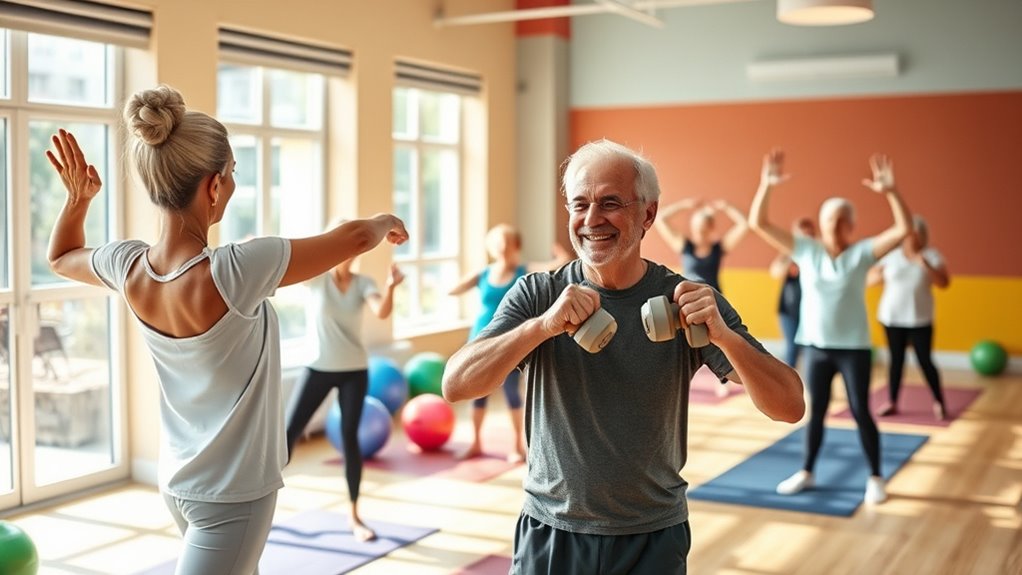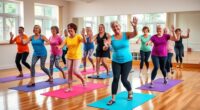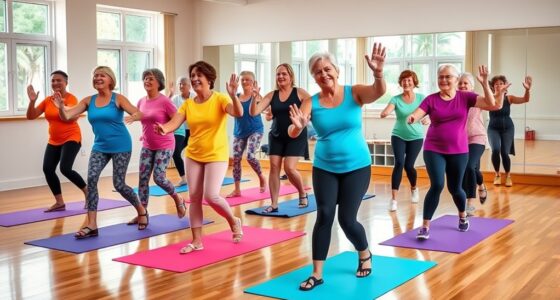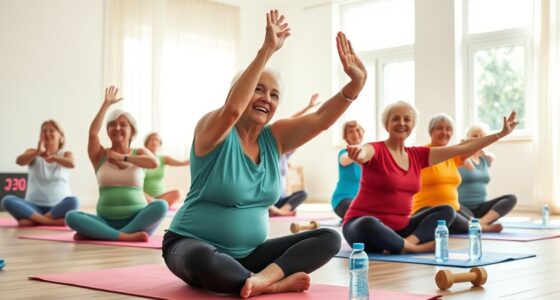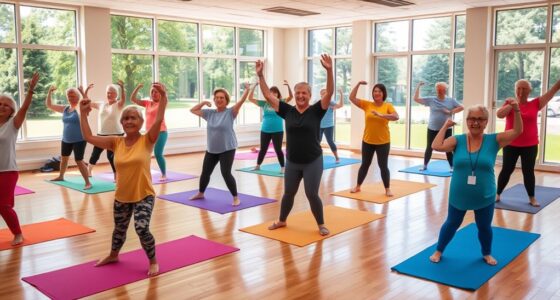Elderly fitness programs are key to improving your health and mobility. Aim for at least 150 minutes of moderate-intensity aerobic activity each week, along with strength training twice per week. Incorporate balance exercises to prevent falls. Look for community support and tailored programs that fit your needs. Gear up with the right equipment to guarantee safety and effectiveness. By following these steps, you’ll build a strong foundation for better health and well-being. There’s so much more to discover!
Key Takeaways
- Aim for at least 150 minutes of moderate exercise weekly, including walking, swimming, and other low-impact activities.
- Incorporate strength training exercises at least twice a week to maintain muscle mass and overall strength.
- Include balance exercises like Tai Chi or heel-to-toe walks three times weekly to reduce fall risks.
- Engage in community-based fitness programs to foster social connections and enhance motivation to stay active.
- Consult healthcare providers before starting new routines, especially if inactive or managing health concerns.
The Importance of Regular Exercise for Seniors
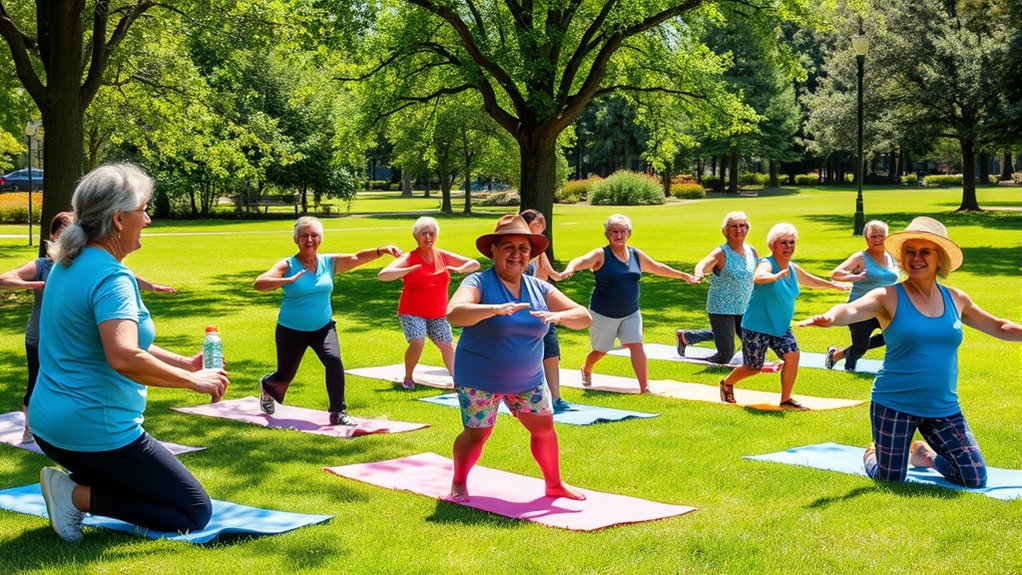
Although you may not feel like it, regular exercise is essential for seniors, as it greatly enhances your mobility, strength, and overall health. Engaging in physical activity can markedly boost your fitness levels, allowing you to maintain independence and improve your quality of life. Additionally, incorporating mindful decluttering strategies into your routine can help create a more organized and motivating environment for exercise. Creating a safe and accessible living space can significantly encourage physical activity and make it easier to stay active. Regular physical activity also helps to mitigate the risk of cognitive decline, which can be exacerbated by aging. Moreover, committing to clear goals can further enhance your fitness journey and keep you motivated.
Unfortunately, less than one-third of older adults meet the recommended 150 minutes of moderate-intensity aerobic activity each week. By committing to regular exercise, you can help prevent health issues associated with aging, like heart disease and obesity. It also improves sleep quality and reduces joint pain. Additionally, participating in community organizations offers tailored exercise programs, ensuring you get the support and resources you need to stay active and healthy. Prioritizing fitness leads to a healthier, happier life.
Recommended Exercise Guidelines for Older Adults

To maintain your health and vigor as you age, it’s important to follow recommended exercise guidelines. Aim for at least 150 minutes of moderate exercise each week, or 75 minutes of vigorous activity.
To stay healthy and energetic as you age, aim for 150 minutes of moderate or 75 minutes of vigorous exercise weekly.
Incorporate strength training exercises on two or more days, focusing on all major muscle groups. Alongside these, include balance exercises at least three times a week to help reduce the risk of falls. Engaging in regular physical activity can also help prevent tick-borne diseases, which is crucial for maintaining both physical and mental well-being. Regular exercise can also support men’s health by promoting cardiovascular fitness and muscle strength. Additionally, incorporating primitive weapons into your fitness routine can enhance coordination and strength in a fun and engaging way. Furthermore, staying active can improve mental clarity and cognitive function as you age.
Don’t forget to break up long periods of inactivity with daily physical activity, as this can greatly enhance your overall physical health. Regular exercise can also help prevent running dry, which is crucial for maintaining both physical and mental well-being.
If you’ve been inactive or have any medical concerns, consulting your healthcare provider before starting a new routine is always a smart idea.
Types of Effective Exercise Programs
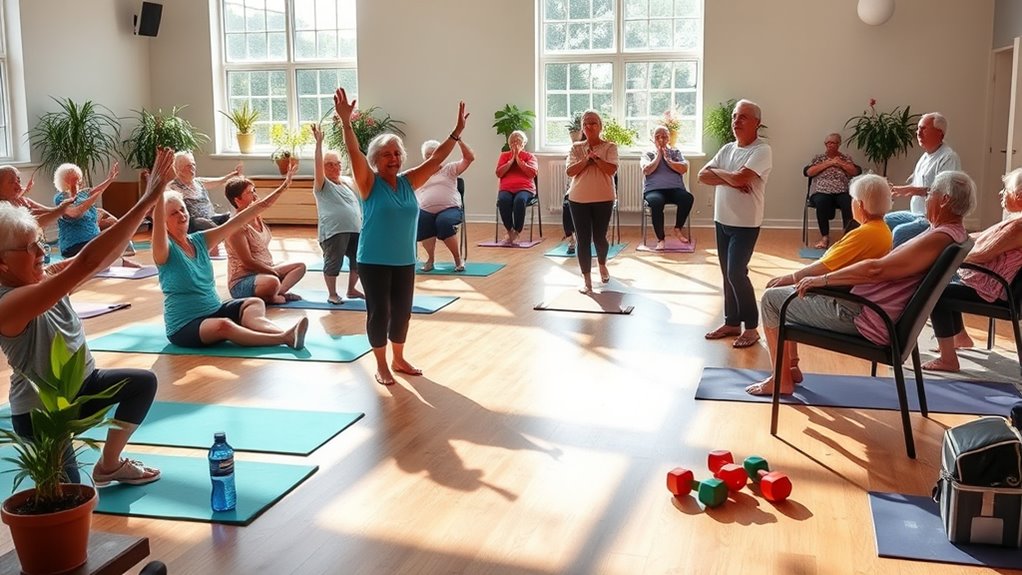
Here are three types that can greatly enhance your health and well-being:
- Low-impact activities like walking and swimming improve cardiovascular health while being gentle on your joints.
- Strength training using light weights and resistance bands helps maintain muscle mass, combating age-related decline.
- Balance exercises such as Tai Chi and heel-to-toe walks boost stability and prevent falls, which is essential for safety.
Incorporating flexibility routines like yoga and stretching enhances your range of motion.
Participating in community-based fitness programs not only provides structure but also fosters social connections, making your fitness journey enjoyable and sustainable. Additionally, engaging in activities that encourage playful communication can further enhance social interaction and emotional well-being among older adults.
Community Support and Resources for Senior Fitness
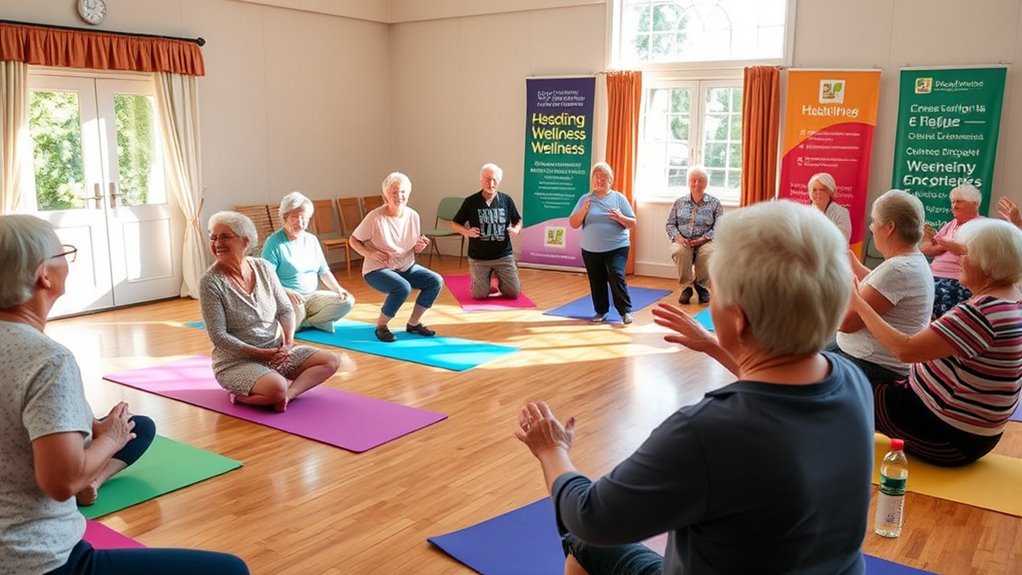
When it comes to staying fit as a senior, local exercise programs can make a big difference in your routine. Portable Camping Toilets can be a great addition to outdoor fitness classes, ensuring comfort and convenience. With funding and grants supporting these initiatives, community partnerships are essential for creating accessible resources tailored to your needs. Engaging in these programs not only boosts your physical health but also connects you with others, enhancing your overall well-being. Additionally, developing a strong support network can significantly improve your motivation and commitment to maintaining a fitness routine. Furthermore, participating in community activities can also help you access local resources that promote health and wellness. Incorporating educational toys into group activities can also provide stimulating exercises that enhance coordination and balance. Many community fitness programs also offer pediatric sleep specialists who can provide guidance on maintaining healthy sleep habits, which is crucial for overall health.
Local Exercise Programs
Many communities offer a variety of local exercise programs designed specifically for seniors, making it easier than ever to stay active and healthy. Engaging in these activities not only boosts your physical health but also enhances your emotional well-being, which is crucial for maintaining children’s well-being after separation. Additionally, participating in regular exercise can help support overall wellness and improve quality of life. Furthermore, advance directives can help ensure that seniors receive the appropriate care they need while staying active and engaged. Staying active can also contribute to resilience in the face of challenges, helping seniors navigate life’s ups and downs more effectively.
Here are three types of programs you might find:
- EnhanceFitness – This evidence-based program focuses on aerobic and strength-building activities.
- Tai Chi for Arthritis – A gentle way to improve balance and mobility while reducing stress.
- Stay Active and Independent for Life (SAIL) – A program that encourages seniors to engage in regular exercise tailored to their needs.
These local resources create a supportive environment, fostering independence and promoting overall health for seniors. Additionally, incorporating solar energy solutions into community centers can further enhance the availability of fitness programs through sustainable power sources. Get involved and enjoy staying active!
Funding and Grants
Accessing funding and grants for senior fitness programs can greatly enhance community resources and support initiatives aimed at keeping older adults active. Organizations like the Administration for Community Living and the CDC provide essential funding to develop effective exercise programs tailored for seniors.
By tapping into these grants, community organizations can implement proven initiatives that foster a supportive environment for fitness. The National Council on Aging (NCOA) connects local agencies to evidence-based exercise programs, boosting seniors’ health and independence.
Additionally, federal funding opportunities specifically target the unique needs of older adults. By advocating for partnerships among community organizations, you can sustain health initiatives and maximize resources for senior fitness, ensuring a healthier future for everyone involved. Moreover, leveraging data analysis speed through automation can help identify effective fitness strategies and enhance program outcomes.
Community Partnerships
Building on the funding and grants available for senior fitness programs, community partnerships play a vital role in enhancing resources and support for older adults.
By collaborating with local organizations, you can access proven exercise programs that boost physical activity and offer significant health benefits.
Here are three ways community partnerships make a difference:
- Access to Proven Programs: Organizations like the NCOA provide valuable resources, ensuring your community’s fitness offerings are effective.
- Enhanced Social Connections: Group exercise fosters friendships, breaking isolation among seniors and improving mental well-being.
- Tailored Initiatives: Local entities work together to create exercise programs that meet the unique needs of older adults, encouraging participation and engagement.
Embracing these partnerships can transform senior fitness in your community!
Specialized Programs for Fall Prevention
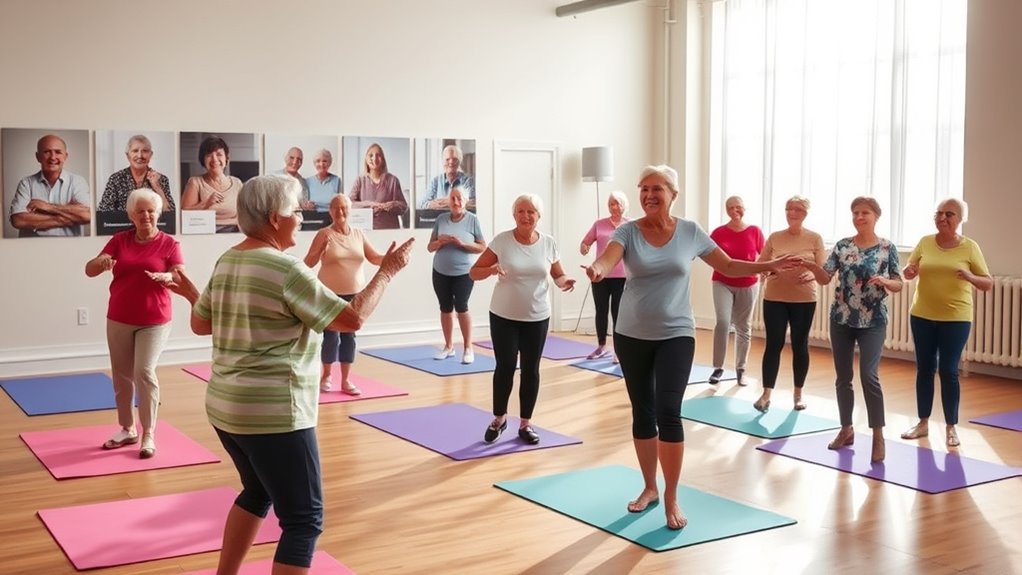
As you age, participating in specialized programs for fall prevention can greatly enhance your balance and mobility, reducing the risk of falls.
Programs like Tai Chi for Arthritis focus on improving movement, strength, and flexibility, while also minimizing pain and social isolation among seniors.
The Tai Chi Prime program offers a six-week series that combines instructional classes with home practice, helping you integrate exercises into your daily routine.
The Tai Chi Prime program integrates instructional classes with home practice for seamless daily exercise incorporation.
Additionally, Tai Ji Quan: Moving for Better Balance® provides functional exercises specifically designed to enhance balance and markedly lower fall risks.
Engaging in community-based programs like Walk with Ease not only increases physical activity but also helps manage pain and reduce feelings of depression, promoting overall well-being among seniors.
Daily Physical Activity Recommendations
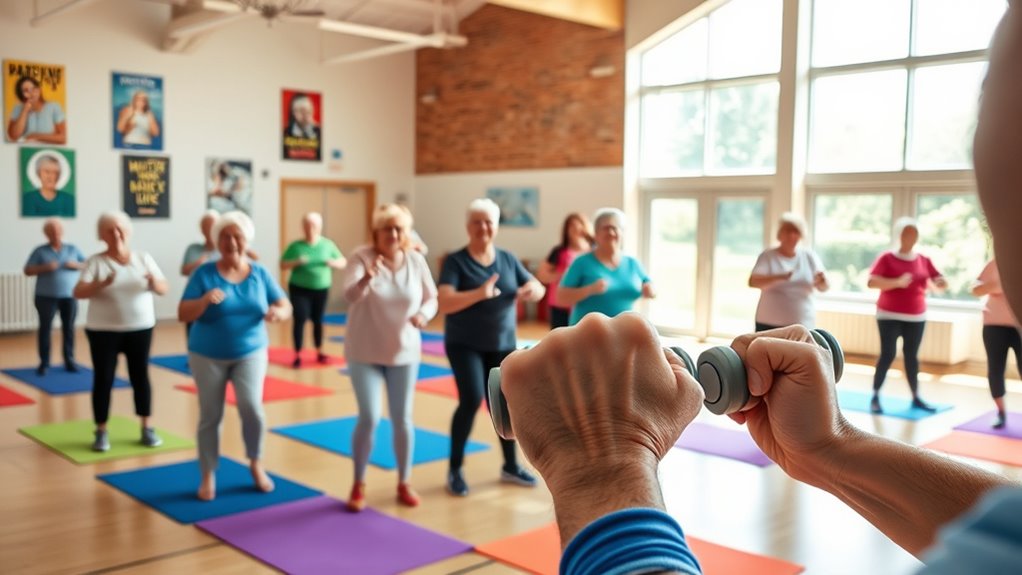
Participating in fall prevention programs can set the stage for incorporating daily physical activity into your routine. Aim for at least 150 minutes of moderate-intensity aerobic activity each week.
Here are some important components to include:
- Muscle-strengthening activities for all major muscle groups at least two days a week to maintain strength.
- Balance and flexibility exercises to enhance stability and reduce the risk of falls.
- Movement throughout the day, like standing or walking, to combat sedentary behavior.
Before starting any new exercise routine, it’s essential to consult with your healthcare provider, especially if you’ve been inactive or have health concerns.
Taking these steps can lead to better health and increased energy in your golden years.
Designing Your Personal Fitness Program
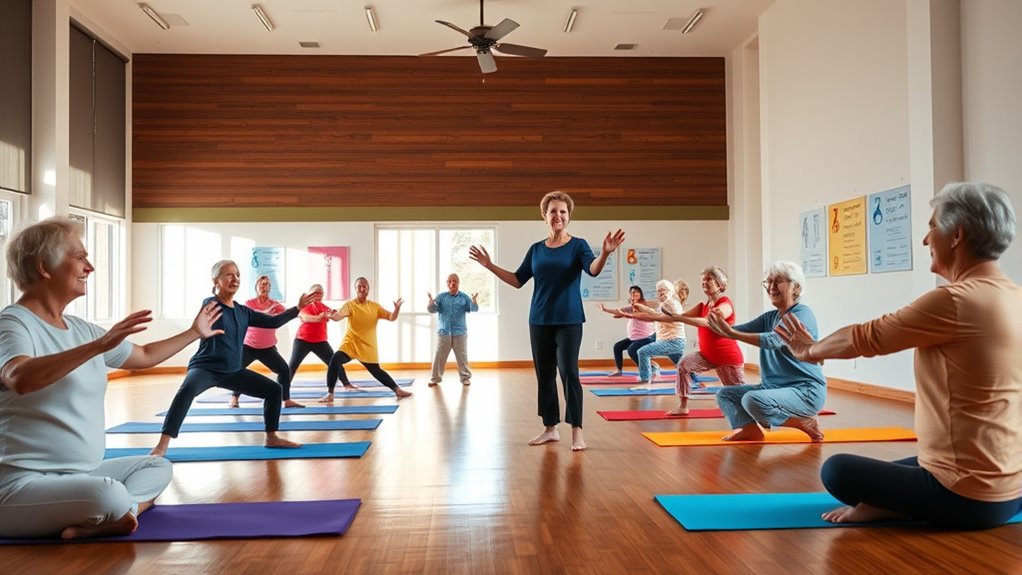
To create a fitness program that works for you, start by setting clear goals that focus on what you want to achieve, like boosting your strength or endurance.
Track your progress regularly to see how far you’ve come and make necessary adjustments.
This approach will help keep you motivated and on the right path to reaching your fitness aspirations.
Set Clear Goals
Setting clear fitness goals is essential for seniors looking to enhance their health and well-being. When you set clear goals, you can stay focused and motivated in your fitness routine.
Here are three goals to evaluate:
- Improve Strength: Aim to include strength training for all major muscle groups at least twice a week.
- Increase Activity Level: Target a minimum of 150 minutes of moderate-intensity aerobic activity each week, gradually increasing your activity level by 10% weekly.
- Maintain a Healthy Lifestyle: Tailor your program to fit your health conditions and preferences, ensuring that exercise helps you feel both safe and engaged.
Regularly reassess and adjust your goals to keep your routine fresh and aligned with your evolving capabilities.
Track Your Progress
Tracking your progress is essential for staying motivated and ensuring you’re on the right path in your fitness journey. Start by measuring your fitness level with baseline assessments—like walking speed or the number of push-ups you can do.
Set specific fitness goals, such as achieving 150 minutes of moderate-intensity activity weekly, to help you track your progress effectively. Regularly assess your fitness level every six weeks to monitor improvements and adjust your exercise routine as needed.
Utilize fitness apps or journals to log your workouts, noting duration, intensity, and personal observations. Celebrate small achievements along the way, as these milestones foster a positive mindset and encourage you to stick with your fitness program.
Tips for Staying Motivated and Consistent
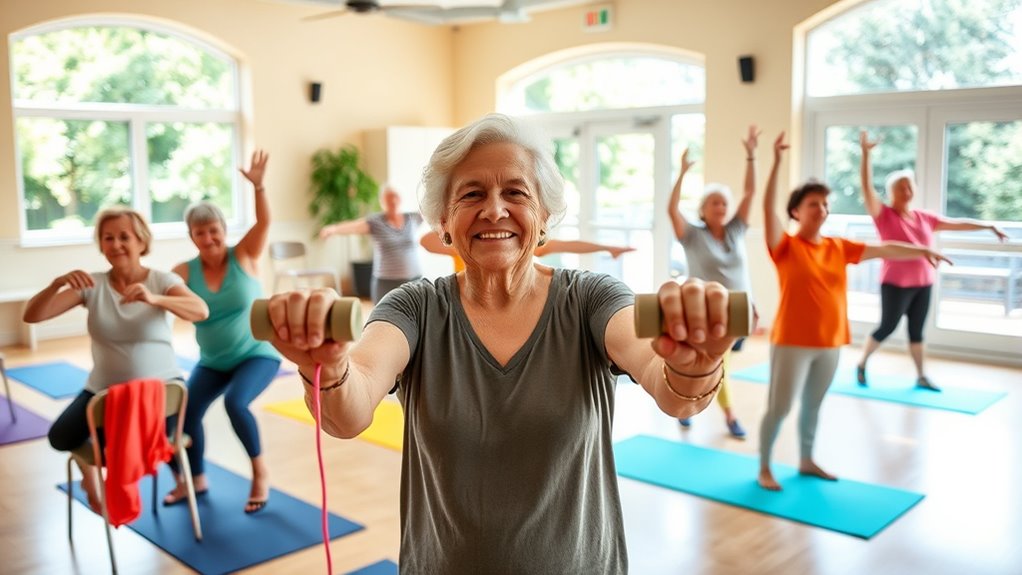
Staying motivated and consistent with your fitness routine can feel challenging, but with the right strategies, you can make it easier.
Here are some tips to help you stay on track with your exercise program:
- Set achievable goals: Gradually increase your exercise duration or frequency to foster a sense of accomplishment and keep motivation high.
- Join group classes: Engaging in social exercise programs can enhance commitment and provide valuable support from others.
- Incorporate variety: Switch between low-impact cardio, strength training, and flexibility exercises to maintain interest and engagement.
Measuring Your Fitness Progress
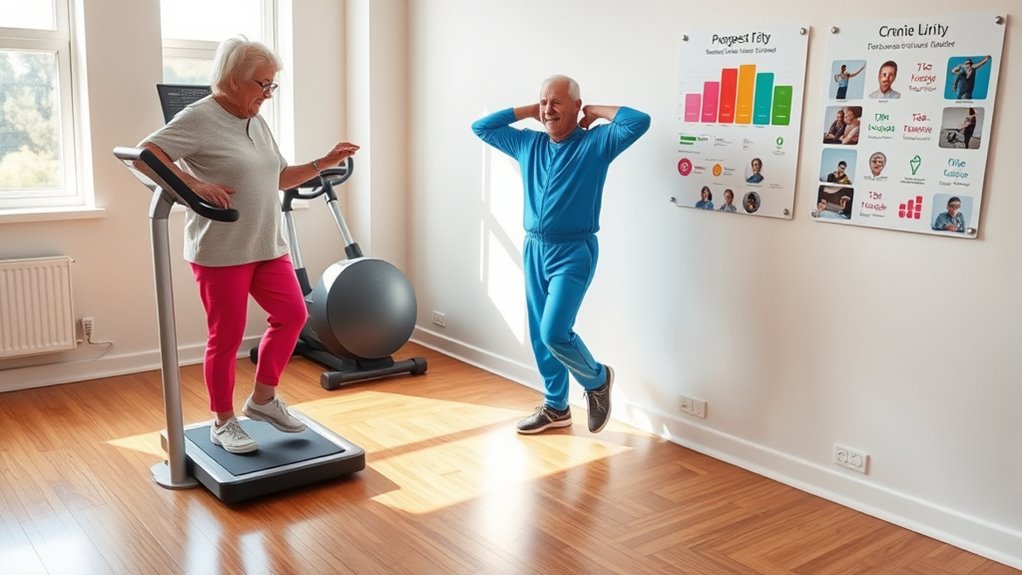
Measuring your fitness progress is vital for understanding how well your exercise routine is working.
To gauge your cardiovascular health, record your pulse rate before and after walking one mile, along with the time it takes you. This helps assess your endurance.
For strength, count how many push-ups—standard or modified—you can do in one go.
Additionally, evaluating your flexibility by checking the range of motion in your hips, knees, and shoulders is imperative.
Don’t forget to measure your waist circumference and calculate your body mass index (BMI) to track changes in body composition.
Regularly tracking progress, ideally every six weeks, guarantees you can adjust your exercises based on your improvements toward your fitness goals.
Essential Equipment for Senior Exercise Programs
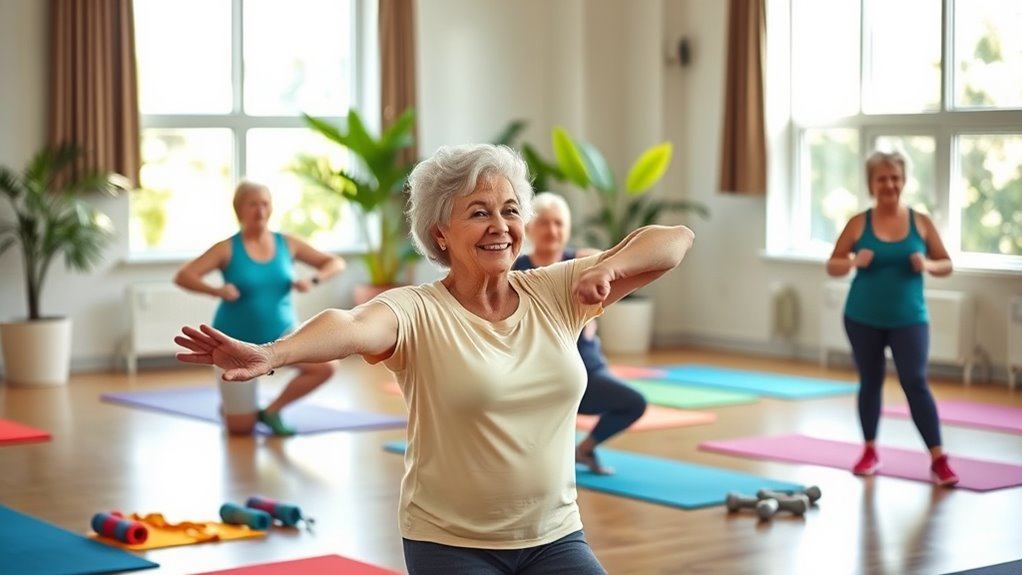
Having the right equipment is essential for making the most of your senior exercise program. To enhance your workouts and guarantee safety, consider these key items:
- Comfortable, supportive athletic shoes – They provide stability and help prevent falls during your activities.
- Resistance bands – These versatile, low-impact tools allow you to engage in strength training safely, whether at home or in a group.
- Light weights – Opt for 1- to 5-pound dumbbells to boost your strength training without straining your joints.
Additionally, stability balls can improve your core strength and balance, while yoga mats offer a comfortable surface for stretching and floor exercises.
With these essentials, you’ll feel empowered and ready to embrace your fitness journey!
Frequently Asked Questions
What Is the Best Exercise Program for Seniors?
The best exercise program for seniors focuses on a mix of activities that promote strength, balance, and flexibility.
Aim for at least 150 minutes of moderate-intensity aerobic exercises like walking or swimming each week. Incorporate muscle-strengthening exercises two days a week.
Consider joining classes like Tai Chi, which enhance balance while fostering social connections. Always choose low-impact options to minimize strain on your joints, ensuring you stay safe and engaged in your fitness journey.
What Is the Appropriate Physical Fitness Program for Senior Citizens?
Have you ever wondered what the best fitness routine is for senior citizens?
An appropriate program includes at least 150 minutes of moderate aerobic activity weekly, plus muscle-strengthening exercises on two or more days.
Don’t forget to add balance and flexibility exercises like Tai Chi or yoga to enhance your stability.
Always consult a healthcare professional to tailor the program to your needs, ensuring it’s safe and effective for your specific health conditions.
What Is the Number One Exercise to Increase Balance in Seniors?
The number one exercise to increase balance in seniors is the single-leg stand. You can practice this by standing on one foot for up to 30 seconds.
Doing this regularly, at least three times a week, can greatly enhance your stability and coordination. By incorporating this simple exercise into your routine, you’ll not only improve your balance but also reduce the risk of falls and boost your confidence in physical activities.
How to Create a Workout Plan for Seniors?
To create a workout plan for seniors, start by evaluating their current fitness level and any health conditions.
Aim for at least 150 minutes of moderate-intensity aerobic activity each week, breaking it into 30-minute sessions.
Include muscle-strengthening exercises twice a week and balance or flexibility activities three times a week.
Regularly reassess the plan every few months to adjust based on progress and changing fitness needs.
This guarantees a safe and effective approach to fitness.
Conclusion
Incorporating regular exercise into your routine can considerably enhance your health and well-being as you age. Did you know that just 150 minutes of moderate-intensity activity each week can reduce the risk of chronic diseases by up to 30%? By following the guidelines and exploring various programs, you’ll not only improve your strength and balance but also enjoy a more vibrant life. So, take those simple steps towards better health—your future self will thank you!
